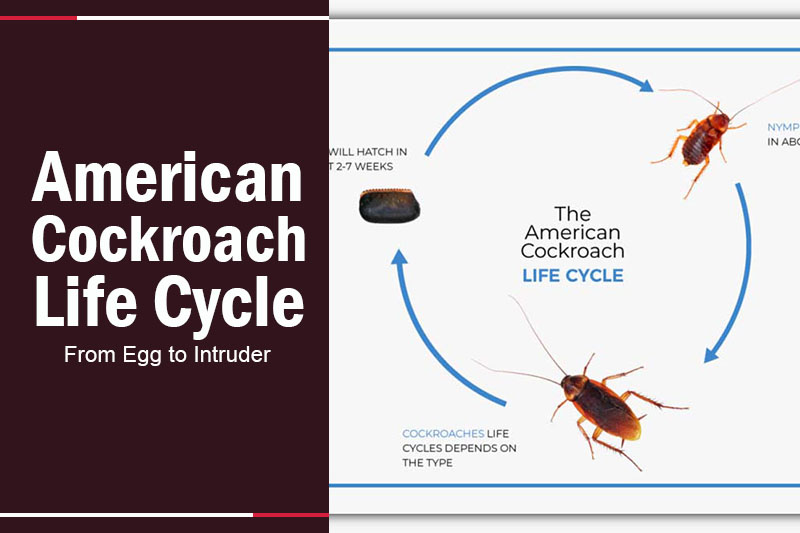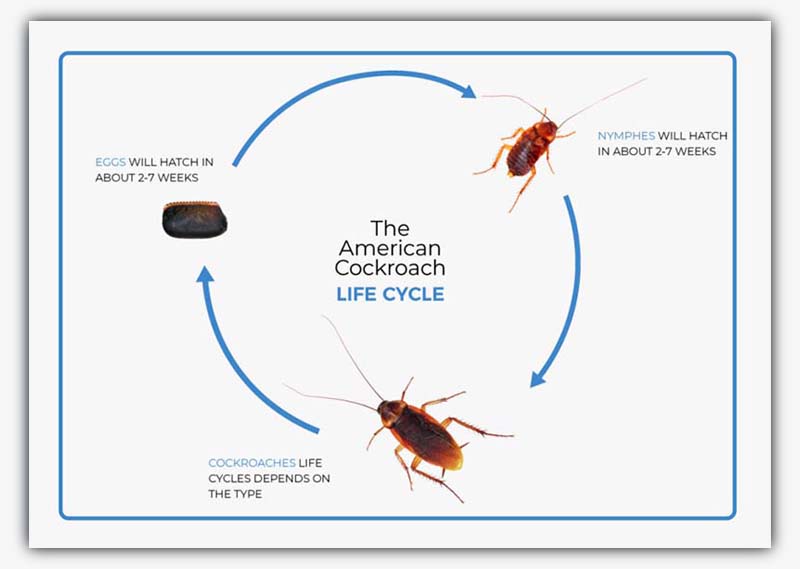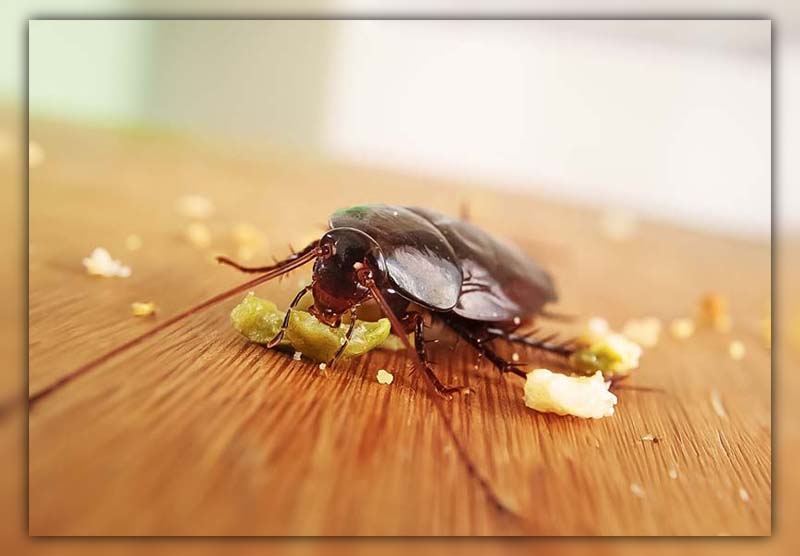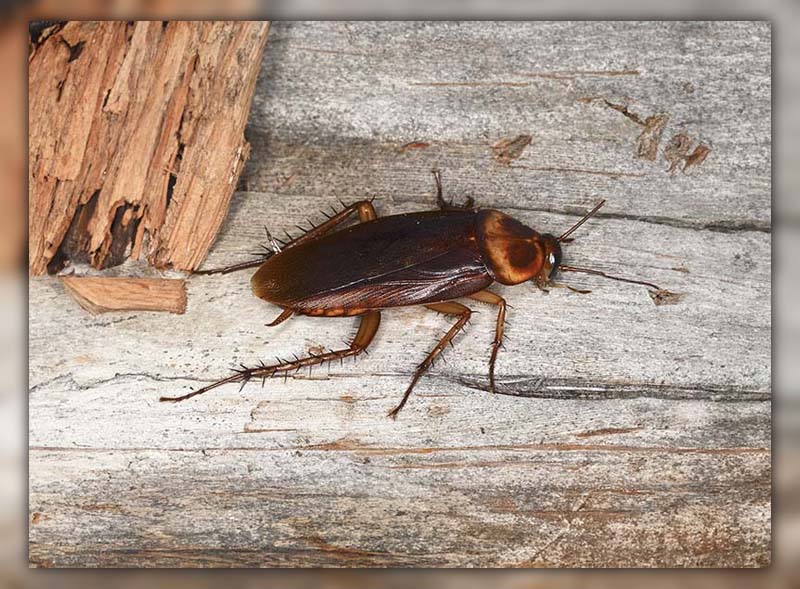The key to effective household pest management is understanding their behaviors and patterns.
Our comprehensive guide on the American Cockroach Life Cycle provides insights and strategies to help you manage these unwelcome guests effectively.

American Cockroach Life Cycle
The American cockroach goes through three main phases in its life: the egg, several stages as a nymph, and then the adult stage.
On average, it takes about 600 days for an egg to transform into an adult cockroach. Once it’s an adult, it can live for almost another year.
Roach nymphs emerge from their eggs in about six to eight weeks, and they take between six to twelve months to mature.
Believe it or not, a female adult roach can bring about 150 baby roaches into the world during her life.
Things like temperature and moisture in their environment play a big role in how fast they grow and develop.
Read more What do roach eggs look like: Decode, Destroy, Reclaim Your Home.
American Cockroach Eggs
After mating, the female American cockroach lays her eggs in a strong, little bag-like case called an ootheca. She makes her first one about a week later.
When she’s most active, she could make two of these egg cases in a week. Generally, she’ll make one every month for ten months, and each case will have around 16 eggs inside.
She often places this egg case near food and sometimes sticks it to things.
The case already has all the water the eggs need to grow.
This egg case starts off as a brown color but gets darker and turns black in a few days.
It’s tiny, just about 8 mm long and 5 mm tall.
American Cockroach Nymph
The young cockroach, or nymph, phase begins when the egg opens up.
The nymph changes its skin, or molts, about 6 to 14 times as it grows. Right after coming out of the egg, the nymph is white but then changes to a brownish-gray color.
Each time it changes its skin, it starts off white and then becomes reddish-brown.
Interestingly, young cockroaches don’t have wings, but by the third or fourth time they molt, you can start to see where the wings will grow.
In total, from being an egg to a grown-up, it’s a 600-day trip.
Both young and adult cockroaches are always searching for food and water.
America Cockroach Adult
When the American cockroach is all grown up, it has a reddish-brown color with a light brown or yellow stripe around its neck area.
The male cockroaches are a bit longer than the females because their wings stick out a bit more.
Both males and females have a pair of skinny, wiggly bits at the end of their body.
The males have 18 to 19 sections on theirs, while the females have 13 to 14.
And only the males have an extra pair of tiny sticks between these wiggly bits; the females don’t have them.
Read more German cockroach: Secrets of the Pesky Pests
The American cockroach’s diet
The American cockroach isn’t picky about its food. It’s an omnivore, which means it can eat both plant and animal materials.
Most of the time, it munches on rotting stuff.
It’ll eat just about anything it finds. While it has a sweet tooth and loves sugary foods, it doesn’t stop there.
Some of the weirdest things it’s been known to eat include paper, old boots, and even hair.
Other items on its varied menu are bread, fruits, book covers, fish, peanuts, stale rice, spoiled drinks like sake, the soft parts of animal skins, fabrics, and even other dead bugs.
What Do American Cockroaches Look Like?
Adult American cockroaches are usually about 1.4” to 1.6” long (35-41mm), but some can grow even bigger than 2 inches!
They have a reddish-brown color with a yellow line right behind their heads.
Both male and female cockroaches have wings. They don’t fly much, but they can go short distances if they need to.
Read more White Roach? Decoding the Pale Pest Mystery
Do American Cockroaches Bite?
Yes, American cockroaches can bite, but it’s rare for them to do so.
If one does bite you, don’t worry too much.
Just keep it clean.
If it looks infected or gets really red and painful, it’s a good idea to see a doctor.
Habits of American Cockroach
American cockroaches love the outdoors but won’t hesitate to move indoors when needed.
If you’re up north in the U.S., you might find these critters in sewers and drains. In fact, they’re champions at taking over city sewers.
Once, someone found more than 5,000 of these roaches in just one sewer hole.
But if you’re down south, look for them in cool, damp places like flowerbeds or under piles of leaves.
In the summer, they enjoy hanging out in backyards and alleys.
They prefer warm, wet, and dark spots, ideally between 70 and 80 degrees Fahrenheit.
They can enter your home hidden in items, through drains, or migrate from places like dumps during hot weather.
Large buildings like restaurants, supermarkets, and hospitals often have the most problems with these roaches.
They’re usually found in places with food like kitchens or storerooms, as well as warm places like boiler rooms and basements.
But they can also sneak into our homes, getting in under doors or through windows and garages.
Inside, they head to kitchens, bathrooms, or basements, looking for food and water.
Speaking of food, American cockroaches aren’t picky.
They’re especially fond of food that’s starting to spoil.
Outside, they munch on rotting leaves, tiny bugs, and algae.
Inside, they’re all about those crumbs under your toaster, in the sink, or on the floor. And if you leave pet food out, they’ll happily help themselves.
Conclusion
In conclusion, understanding the American Cockroach Life Cycle is essential for effectively managing these unwelcome guests.
Don’t forget to explore more enlightening articles from Pestweek to fortify your knowledge on various pests. Every story shared is a step closer to a pest-free world!

Calina Mabel has over 15 years of experience in the field of journalism and communications. Currently, Calina Mabel is the Content Writer for categories such as Cockroach, Ants, Bed Bugs, Mosquito, Rodent, Termite, and Flies on Pestweek.com. She aims to build content for these categories with a focus on providing valuable and accessible information to readers, in order to create the world’s largest knowledge community about Pests.
All content written by Calina Mabel has been reviewed by Emily Carter.




